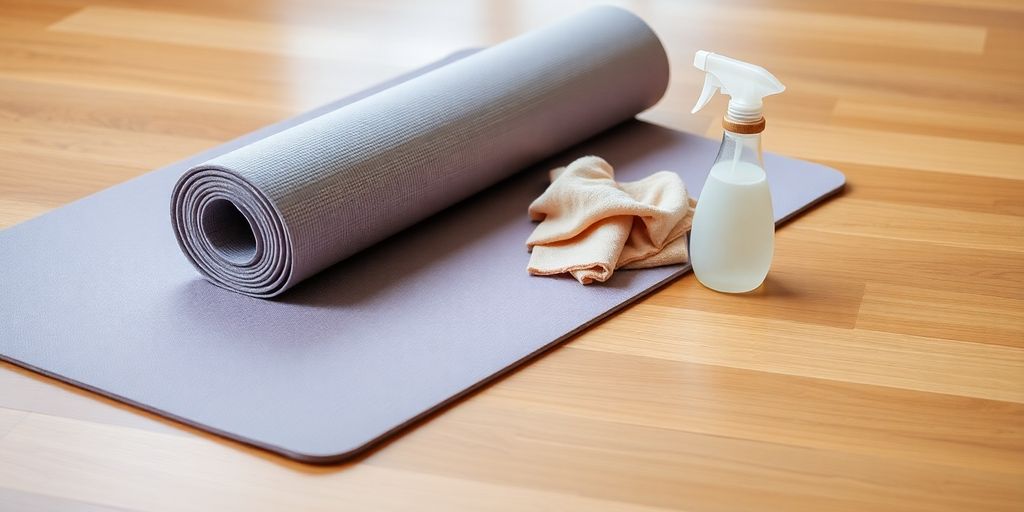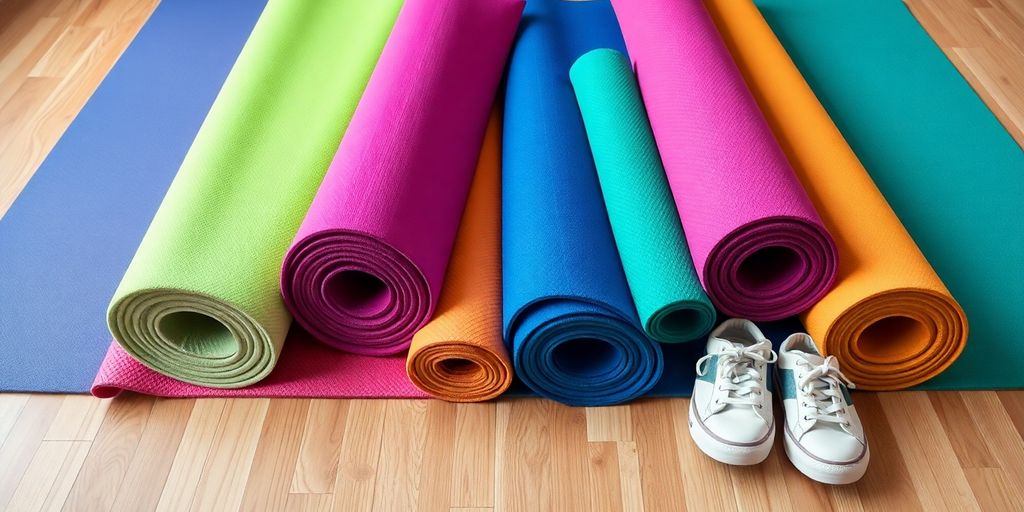
How Do You Clean a Yoga Mat: Essential Tips for Maintaining Your Practice
Cleaning your yoga mat might not be the first thing on your mind when you roll it out for practice, but it’s super important. Over time, mats can collect sweat, dirt, and bacteria, which can affect your health and your practice. This article will give you the lowdown on how do you clean a yoga mat effectively, so you can keep your practice space fresh and safe. Let’s dive into the details!
Key Takeaways
- Regularly clean your mat to prevent bacteria buildup.
- Wipe down your mat after each use, especially if you sweat a lot.
- Use natural cleaning solutions to protect the mat's material.
- Check the manufacturer's instructions for specific care guidelines.
- Replace your mat if you notice significant wear or loss of grip.
Understanding The Importance Of Cleaning Your Yoga Mat
Health Risks Associated With Dirty Mats
Okay, so let's be real. Your yoga mat? It's a breeding ground for all sorts of gross stuff. We're talking bacteria, fungi, the whole shebang. Think about it: you're sweating all over it, maybe even tracking in dirt from your shoes (guilty!). All that moisture and warmth? Perfect conditions for some unwanted guests. And it's not just a matter of being a little grossed out. We're talking potential skin infections, especially if you're hitting up public classes. No thanks!
Enhanced Performance Through Cleanliness
Ever tried doing a downward dog on a slippery mat? Not fun. A dirty mat can get slick with sweat and oils, making it harder to hold your poses. Plus, there's the whole mental aspect. It's tough to get into that zen state when you're staring at a stain or catching a whiff of something funky. A clean mat helps you maintain balance and focus, so you can actually get the most out of your practice.
Longevity Of Your Yoga Mat
Think of your yoga mat like your favorite pair of jeans. You wouldn't wear them every day without washing them, right? Same goes for your mat. All that sweat, dirt, and oil can break down the material over time, leading to cracks, tears, and a generally sad-looking mat. Regular cleaning helps preserve the texture and grip, so you don't have to replace it as often. Plus, it's just a good way to respect your investment.
Keeping your yoga mat clean isn't just about hygiene; it's about respecting your body, your practice, and your gear. A little bit of maintenance goes a long way in ensuring a safe, enjoyable, and long-lasting yoga experience.
How Often Should You Clean Your Yoga Mat
It's easy to forget about cleaning your yoga mat, but it's super important for hygiene and the mat's lifespan. How often you clean really depends on how often you use it and what kind of yoga you're doing. Let's break it down.
General Cleaning Guidelines
Ideally, you should wipe down your mat after every use. This is especially true if you're doing hot yoga or sweating a lot. Think of it like wiping down gym equipment after you use it – it's just good practice. A quick wipe-down prevents the buildup of sweat, oils, and dirt. For a more thorough clean, aim for at least once a week, especially if you're using your mat daily. Monthly, give your mat a good checkup for any wear, smells, or stains.
Factors Influencing Cleaning Frequency
Several things can affect how often you need to clean your mat:
- Type of Yoga: If you're doing intense styles like Ashtanga or Bikram, you'll need to clean more often because of the sweat.
- Personal Hygiene: If you sweat a lot or have skin conditions, more frequent cleaning is a must.
- Shared Use: If you're using a shared mat at a studio, always clean it after each use to avoid spreading germs. Studios should provide cleaning supplies, but it's always good to double-check.
Think of your yoga mat like your toothbrush – you wouldn't share it, and you'd clean it regularly. The same principle applies here. A clean mat is a happy mat (and a happy you!).
After Each Use Recommendations
After each session, take a minute to wipe down your mat. Keep a spray bottle with a mild cleaning solution handy. Here's what you can do:
- Spray the entire surface of the mat.
- Wipe it down with a clean cloth.
- Let it air dry completely before rolling it up. This prevents moisture from getting trapped and causing mildew. It's a small step that makes a big difference in keeping your yoga mat clean.
Effective Cleaning Methods For Your Yoga Mat

Basic Cleaning Techniques
Okay, so you've been hitting the yoga studio hard, and your mat is starting to look... well, loved. Don't stress! Basic cleaning is super easy. The most common method is simply wiping down your mat after each use. You'll need a spray bottle filled with a cleaning solution and a soft cloth. A simple mix of water and a bit of mild soap works wonders.
- Spray the solution lightly over the entire surface of the mat.
- Wipe it down thoroughly with the cloth, making sure to get into any grooves or textures.
- Let the mat air dry completely before rolling it up. Nobody wants a moldy mat!
Using Natural Cleaning Solutions
If you're like me, you're probably trying to avoid harsh chemicals whenever possible. Luckily, there are tons of natural cleaning solutions that are perfect for yoga mats. One popular option is a mixture of equal parts water and white vinegar. You can even add a few drops of tea tree oil for its antibacterial properties. I've been using tea tree oil for years.
Natural cleaning solutions are not only better for the environment but also gentler on your skin and your mat. Plus, they often smell amazing!
Here's a quick recipe:
- Mix equal parts water and white vinegar in a spray bottle.
- Add 5-10 drops of tea tree oil (optional).
- Shake well before each use.
Avoiding Harsh Chemicals
This is a big one. Harsh chemicals can seriously damage your yoga mat, not to mention irritate your skin. Avoid using bleach, strong detergents, or anything with a super strong scent. These can break down the material of your mat and leave behind residue that's hard to get rid of. Always stick to gentle, natural solutions or mild soap and water to keep your mat in tip-top shape. Trust me, your mat (and your body) will thank you for it. I once used a cleaner that was too strong, and it completely ruined the surface of my mat. Learn from my mistakes!
Tips For Maintaining A Clean Yoga Mat

Regular Inspections For Damage
It's easy to forget about the small things, but checking your mat regularly is super important. Look for tears, cracks, or any spots that seem worn down. Catching these early can prevent them from getting worse and potentially save you from needing a new mat sooner than expected.
Proper Storage Techniques
How you store your mat can really affect how long it lasts. Don't just chuck it in a corner! Ideally, you want to keep it in a cool, dry place, away from direct sunlight. Sunlight can break down the material over time, especially for rubber mats. Rolling it up is better than folding it, as folding can create creases that weaken the mat. Think of it like storing a sleeping bag – you wouldn't want to keep it stuffed in a sack all the time.
- Keep your mat away from direct sunlight.
- Store it in a cool, dry place.
- Roll it up instead of folding.
Keeping It Personal For Shared Mats
If you're using a mat at a studio or sharing with others, it's extra important to be mindful of hygiene. Consider using your own yoga mat cleaner before and after each use, even if the studio provides cleaning supplies. It's also a good idea to bring your own towel to place on top of the mat, creating a barrier between you and any potential germs.
Think of it this way: you wouldn't share a toothbrush, right? While a yoga mat isn't quite the same, it's still a surface that comes into close contact with your skin, so taking those extra steps to keep it clean is always a good idea.
Making Cleaning A Part Of Your Routine
It's easy to let cleaning your yoga mat slide, but think of it as part of your practice, just like your warm-up or cool-down. Integrating mat care into your routine ensures a cleaner, healthier, and more enjoyable yoga experience.
Establishing A Cleaning Schedule
Consistency is key. Decide on a cleaning schedule that works for you and stick to it. Here's a possible breakdown:
- After each use: Quick wipe-down with a DIY yoga mat spray.
- Weekly: More thorough cleaning with soap and water or a specialized mat cleaner.
- Monthly: Deep clean to remove buildup and odors.
Incorporating Cleaning Into Your Practice
Make cleaning part of your post-yoga ritual. Keep cleaning supplies handy, so it's easy to wipe down your mat after each session. Think of it as a way to close your practice and prepare for the rest of your day. It's also a good idea to check for any damage during this time.
Educating Others About Mat Hygiene
If you attend group classes, consider sharing your knowledge about mat hygiene. Encourage others to clean their mats regularly to maintain a healthy environment for everyone. You could even share your favorite cleaning recipes or cleaning tips. Lead by example and show how easy it is to keep your mat clean and fresh.
Cleaning your yoga mat isn't just about hygiene; it's about respecting your practice and your body. A clean mat creates a more inviting and focused space for your yoga sessions. It's a small act that can make a big difference in your overall well-being.
Understanding Different Mat Materials
It's easy to think all yoga mats are created equal, but the material makes a huge difference in how you care for them. What works wonders on a rubber mat could ruin a synthetic one. So, let's break down the common types and how to treat them right.
Cleaning Guidelines For Rubber Mats
Rubber mats, especially those made from natural rubber, are popular for their grip and eco-friendliness. However, they're also more sensitive to harsh chemicals and excessive moisture.
- Avoid alcohol-based cleaners, as they can dry out the rubber and cause it to crack over time.
- Stick to mild soap and water, or specialized rubber mat cleaners.
- Always air dry your rubber mat away from direct sunlight to prevent damage.
I've found that a simple mix of water and a tiny bit of dish soap works best for my rubber mat. I spray it on, wipe it down, and let it air dry. It keeps it clean without any weird smells or damage.
Care Instructions For Cotton Mats
Cotton mats are often used in Mysore-style yoga or as a top layer for added absorbency. They're super different from rubber or synthetic mats because they're absorbent and need a different cleaning approach.
- Machine washing is usually okay, but check the label first.
- Use cold water and a gentle cycle to prevent shrinking or fading.
- Tumble dry on low heat or hang to dry. Make sure it's completely dry before storing it to avoid mildew.
Best Practices For Synthetic Mats
Synthetic mats, like those made from PVC or TPE, are durable and easy to care for, but they still need some love. These are often the most budget-friendly options, so you see them everywhere.
- Wipe down after each use with a damp cloth to remove sweat and dirt.
- For deeper cleans, use a mild soap and water solution or a mat cleaner designed for synthetic materials.
- Avoid using abrasive scrubbers, as they can damage the surface of the mat.
Here's a quick comparison table:
| Material | Cleaning Method | Drying Method | Cautions |
|---|---|---|---|
| Rubber | Mild soap & water, mat cleaner | Air dry, no sunlight | Avoid alcohol, excessive moisture |
| Cotton | Machine wash (gentle), cold water | Tumble dry low/hang | Check label, prevent mildew |
| Synthetic (PVC/TPE) | Damp cloth, mild soap & water | Air dry | Avoid abrasive scrubbers |
Signs That Your Yoga Mat Needs Replacement
It's easy to get attached to your yoga mat. It's been with you through countless flows, supported you in challenging poses, and absorbed all the sweat and grime along the way. But like any well-loved item, yoga mats don't last forever. Knowing when to say goodbye is important for your safety and hygiene. A worn-out mat can compromise your practice and even pose health risks.
Identifying Wear And Tear
Take a good look at your mat. Are there cracks, tears, or flaking? Is the surface uneven or starting to crumble? These are clear signs of wear and tear. Small imperfections might seem minor, but they can quickly worsen and affect your grip and stability. If you notice significant damage, it's probably time to consider a new mat. Regular inspections for damage can help you identify these issues early on.
Recognizing Loss Of Grip
One of the most obvious signs that your mat needs replacing is a loss of grip. If you find yourself slipping and sliding during poses that you used to hold easily, your mat's surface may have deteriorated. This can be dangerous, as it increases the risk of injury. A good yoga mat should provide a firm, stable surface, allowing you to focus on your alignment and breath. If your mat is no longer providing that, it's time for an upgrade. Consider the cleaning guidelines for your mat material before deciding it's a grip issue and not just a cleaning one.
When To Consider A New Mat
Beyond the obvious signs of wear and tear, there are other factors to consider when deciding if it's time for a new mat. Think about how long you've had your current mat and how frequently you use it. Even with proper care, mats eventually break down over time. If you've had your mat for several years and use it regularly, it may be time to invest in a new one, even if it doesn't show obvious signs of damage. Also, consider the hygiene aspect. Despite regular cleaning, mats can harbor bacteria and fungi. If you're concerned about hygiene, replacing your mat may be the best option. Think about establishing a cleaning schedule to extend the life of your next mat.
It's easy to put off replacing your yoga mat, especially if you're on a budget. However, a worn-out mat can actually cost you more in the long run, both in terms of potential injuries and the need for more frequent replacements. Investing in a quality mat that provides good support and grip is a worthwhile investment in your health and well-being.
Wrap-Up: Keep Your Mat Fresh and Your Practice Strong
In the end, keeping your yoga mat clean is super important for both your health and your practice. A clean mat helps you avoid germs and gives you a better grip, which is key for those tricky poses. Plus, it can make your practice feel more focused and peaceful. So, whether you’re wiping it down after every session or giving it a thorough clean once a month, just make it part of your routine. Your mat will thank you, and you’ll enjoy your yoga sessions even more. Remember, a little care goes a long way!
Frequently Asked Questions
Why is it important to clean my yoga mat?
Cleaning your yoga mat is important because it helps remove sweat, dirt, and bacteria that can build up over time. This keeps you healthy and makes your practice more enjoyable.
How often should I clean my yoga mat?
You should clean your yoga mat about once a week. If you sweat a lot or practice frequently, it's a good idea to wipe it down after each use.
What are the best ways to clean a yoga mat?
You can clean your yoga mat by wiping it down with a damp cloth and a natural cleaning solution. Avoid soaking it in water.
Can I use any cleaning products on my yoga mat?
No, avoid using harsh chemicals like bleach. It's best to use natural cleaners, as they are safer for both you and your mat.
How do I store my yoga mat properly?
Store your yoga mat in a cool, dry place away from direct sunlight. Rolling it up instead of folding it helps keep its shape.
When should I replace my yoga mat?
You should consider replacing your yoga mat if you notice it is worn out, has lost its grip, or has visible damage.

